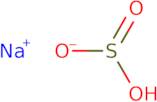Sodium bisulfite
CAS: 7631-90-5
Rif. 3D-FS47144
| 1kg | Fuori produzione | ||
| 2kg | Fuori produzione | ||
| 5kg | Fuori produzione | ||
| 10kg | Fuori produzione | ||
| 250g | Fuori produzione | ||
| 25kg | Fuori produzione | ||
| 500g | Fuori produzione |
Informazioni sul prodotto
- Sodium hydrogen sulfite
- E 222
- Fr-62
- Hc 007
- Hidrogenosulfito De Sodio (Solucion Acuosa)
- Hydrogen sodium sulfite
- Hydrogen sulfite sodium
- Hydrogenosulfite de sodium
- Monosodium sulfite
- Natriumhydrogensulfit
- Vedi altri sinonimi
- Sodium Bisulfite
- Sodium Hydrogen Sulphite (1LB/BT) A.R.
- Sodium Hydrogensulfite
- Sodium Hydrogensulphite
- Sodium acid sulfite
- Sodium bisulfite (NaHSO3)
- Sodium bisulfite (NaHSO<sub>3</sub>)
- Sodium bisulphite
- Sodium bisulphite (1:1)
- Sodium hydrogensulfate
- Sodium hydrogensulfite (aqueous solution)
- Sodium sulfite (NaHSO3)
- Sodium sulfite (NaHSO<sub>3</sub>)
- Sulfurous acid, monosidum salt
- Sulfurous acid, sodium salt (1:1)
- Sulfurous acid, monosodium salt
Sodium bisulfite is an inorganic salt with the chemical formula NaHSO3. It is a reducing agent that converts sulfites to sulfates. Sodium bisulfite is used as a model system for polymerase chain reaction (PCR) and has been shown to inhibit receptor activity in vitro. The optimum concentration for sodium bisulfite varies depending on the type of disease it is used for, but concentrations between 0.2-0.4 M are generally sufficient. Sodium bisulfite has been used as a method for analyzing DNA and RNA samples and can also be used to treat wastewater. This compound has been shown to have low toxicity when administered orally or intravenously in animals, but high doses can cause bowel disease, nausea, vomiting, and diarrhea when given orally. Electrochemical impedance spectroscopy has also been used to measure the reactivity of sodium bisulfite with various compounds.br>br>





